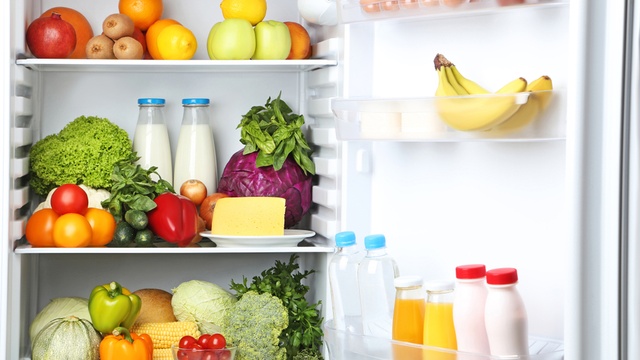Making all your food fit into the fridge can be a puzzle. But keeping your groceries organised can help them stay fresher for longer.
Use this plan to organise your fridge, and you'll be able to cut back on grocery shopping, and maximise the shelf life of your shop.
Fridge door
This is the warmest part of your fridge. Contrary to popular belief, you shouldn't keep your milk in the fridge door. Reserve this part for jams, chutneys, and mustard - anything with preservatives. You can also store things like tomato ketchup and fruit juices here as well.
Upper shelf
The upper shelf is the second warmest part of your fridge. Keep cooked meats here and any other food that doesn't require cooking, such as leftovers. You can also keep cooked snack food on this shelf, like pasties and scotch eggs. Don't put any raw meat or fish on the top shelf. It's not cold enough and, it's a contamination risk if juices were to drip down.
Lower shelf
Keep your raw meat and fish here. It's the coldest part of the fridge so raw products here will stay fresher for longer. It also keeps raw food well away from the cooked products on the top shelf.
Middle shelf
It's best to keep your dairy products on the middle shelf of your fridge. Store your milk at the back, where it's colder. Also on this shelf should be cheese, butter, and cream.
Drawers
The drawers are the best place to keep salad items, fruit, and vegetables. Only keep your tomatoes in the fridge when they’re fully ripe. Tomatoes are best kept on your kitchen counter to let them ripen and develop their flavour. When ripe, they can go in the fridge to prolong their life, but they should be taken out several hours before eating.
What not to store in the fridge
If you're always running out of room in your fridge, there are some items that don't need to be refrigerated. Potatoes, onions, bread, whole melons, avocados, bananas and honey can be all kept in your pantry or in a fruit bowl. Eggs don't need to be kept in the fridge either - they're fine stored at room temperature.
Top storage tips
Once you've organised your fridge, take it to the next level with these extra tips.
- fruit, veg, and salad items should be removed from any plastic bags - storing them in containers lined with kitchen towel will make them last longer because they won't sweat
- invest in some clear containers of different sizes for keeping food in. Your fridge will stay tidy and allow you to see at a glance what you’ve got
- airtight containers are good for storing leftovers and for decanting open tins
- space saver baskets that attach to shelves help you make use of unused space
- when you buy new food store it near the back of the fridge and move older food to the front - this way you’ll use up the food that’s closer to its “use by” date
- wash the inside of your fridge regularly to keep odours at bay and check for expiring food. Take everything out and store food in insulated bags while you give it a good clean.
Lastly, don’t overfill your fridge. This stops air from circulating and can block the vents. Try to keep your fridge around 75% full for maximum efficiency.
Disclaimer: We make every effort to ensure content is correct when published. Information on this website doesn't constitute financial advice, and we aren't responsible for the content of any external sites.








